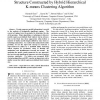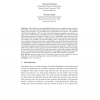650 search results - page 3 / 130 » Analysis and design of sequencing rules for car sequencing |
BIBM
2008
IEEE
14 years 1 months ago
2008
IEEE
— Protein sequence motifs information is crucial to the analysis of biologically significant regions. The conserved regions have the potential to determine the role of the protei...
BIBM
2008
IEEE
14 years 1 months ago
2008
IEEE
Identifying functionally important sites from biological sequences, formulated as a biological sequence labeling problem, has broad applications ranging from rational drug design ...
BMCBI
2008
13 years 7 months ago
2008
Background: Genome survey sequences (GSS) offer a preliminary global view of a genome since, unlike ESTs, they cover coding as well as non-coding DNA and include repetitive region...
BMCBI
2008
13 years 7 months ago
2008
Background: The explosive growth of biological data provides opportunities for new statistical and comparative analyses of large information sets, such as alignments comprising te...
JUCS
2006
13 years 7 months ago
2006
: The need for processing biological information is rapidly growing, owing to the masses of new information in digital form being produced at this time. Old methodologies for proce...


